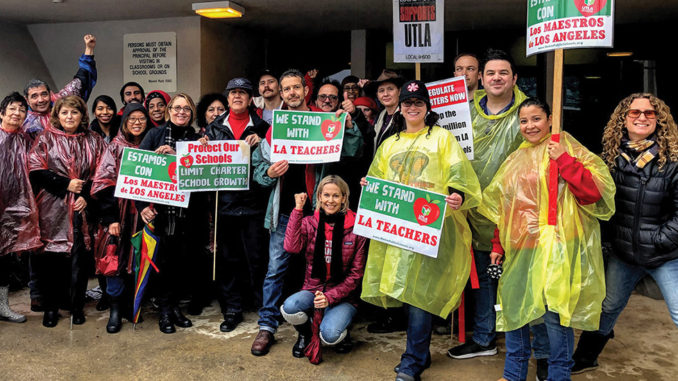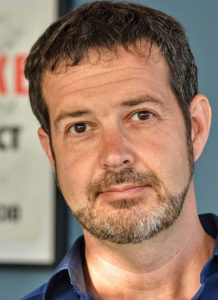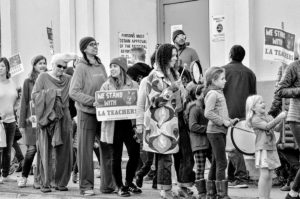
by Rob Callahan
Last June, my column in these pages invoked the cinematic trope of the cliffhanger to describe a moment in which organized labor in the US teetered precariously between potential catastrophe and potential renaissance.

That column was motivated in large part by the then-looming Supreme Court decision in Janus v. AFSCME. The decision itself, once the Court handed it down, outlawed union security clauses in the public sector, rendering all public-sector employment “right-to-work.” (So-called “right to work” laws discourage strong unions by mandating “open shops,” in which individual employees can opt out of the unions representing them.) Janus had been widely anticipated to deliver a devastating – potentially even mortal – blow to our labor movement.
While last June we saw in Janus our looming doom, the state of trade unionism, I asserted, could be characterized as two-faced. On the flip side, several trends appeared to signal that organized labor in the US, long on the decline, could conceivably rebound. These included a significant uptick in private-sector organizing, increased pro-union sentiment in public opinion polling and, most remarkably, the eruption of militant worker actions best exemplified by the #RedForEd movement – in which tens of thousands of teachers nationwide defied expectations, the law and sometimes even their own unions to shut down schools and demand a reinvestment in public education.
So if the labor movement then could be seen as dangling from a cliff face, poised between a precipitous fall and a dramatic comeback, how has that suspenseful situation been resolved? The short but unsatisfying answer is that it has not been resolved. We continue to face down grave – possibly even existential – threats.
Emboldened by anti-union forces’ victory in Janus, the American Legislative Exchange Council (ALEC) – a right-wing group widely credited with having orchestrated the legal rollback of union rights in Wisconsin, Michigan and other states a decade ago – has unveiled a new raft of anti-union legislation it intends to push. Labor’s enemies also continue to attack in the courts; Uradnik v. Inter Faculty Association, currently on appeal to the Supreme Court, could outlaw public employees’ election of unions as their exclusive representatives, upending the legal mechanisms for public-sector bargaining.
Meanwhile, anti-union outfits have sought to maximize the damage of Janus. Union antagonists such as the Freedom Foundation and the Mackinac Center for Public Policy have used public records to identify and contact public employees, aggressively soliciting them to renounce their union memberships. “You now have a real choice,” read one such solicitation, e-mailed to 500,000 New York state public employees by the group New Choice NY. “For decades, public employees in New York were told to pay the union or quit their job. Those days are over.”
The long-term impacts of such lobbying and counter-organizing remain unclear. A little more than half a year after I advanced the metaphor, the notion of a cliffhanger remains apt. We’re still hanging…
Still hanging, but we’re not yet hanged. Indeed, the way in which we are hanging in has exceeded even some of the more optimistic inklings I included in my column last summer.
Although some union members have indeed quit in the aftermath of Janus, there hasn’t yet been nearly the epic exodus of defections that many predicted. In advance of the ruling, some unions had braced themselves for losses exceeding 10 percent. Hard data on the impact of Janus to date are hard to find, but most observers agree that union members have not begun to renounce their memberships in droves.
Many public sector unions rethought and redoubled their organizing efforts in anticipation of Janus, and several are reporting that the new members drawn in by those efforts more than offset those lost to defections. When co-workers are having earnest conversations in the workplace about the importance of remaining unified, those relationships effectively blunt any potential effect of a piece of junk mail from a right-wing think tank, ballyhooing how much money workers can save by stopping dues payments.
Not only have we not seen dramatic attrition in the half-year since Janus, not coincidentally we have seen dramatic action.
In the private sector, probably the most prominent example of militant action in the latter part of 2018 was the eight-city, 8,000-worker strike against Marriott Hotels. It drew upon broader struggles for justice – namely, the Fight for 15 and #MeToo movements – to frame the workers’ demands for living wages and protections from sexual harassment and assault in the workplace. The hotel workers won big, securing both dramatic raises (housekeepers in San Francisco saw raises of roughly 17 percent) and stronger protections against workplace abuse.
Out of the Classroom and Onto the Streets
But the most dramatic example of recent labor militancy has come, again, from teachers. Inspired by prior #RedForEd actions and frustrated by two years of unproductive negotiations with the Los Angeles Unified School District (LAUSD), upwards of 30,000 LA educators left their schools to take to the streets this January. Their week-long strike proved to be a compelling demonstration of collective action’s transformative power.
Like many of you, I was proud to don red and walk the picket lines in solidarity with LA teachers, both at the school my kid attends and at Gardner Street Elementary, the school Local 700 jointly adopted with Local 600 during this strike. The courage and cohesion these educators exhibited was profoundly stirring. These are folks who give immeasurably of themselves in the classroom to offer love, wisdom and strength to the most valuable and most vulnerable members of our community. And they have left those classrooms to give of themselves in the streets, demanding respect for their profession and demanding investment in the students in their charge.
The greater portion of their strike coincided with the nastiest series of storms to drench the Southland in some time but, deluge notwithstanding, spirits on the line remained undamped. I salute the schoolteachers’ indefatigable spirit and give kudos to all of you who offered your solidarity to help them weather this struggle.
Much has been written about the achievements the teachers secured at the table – raises, reduced class sizes and full-time nurses in every school, among other improvements in working conditions and educational practices. Although they didn’t win everything they had sought, the educators made huge strides toward their goals. Beyond the specific clauses of the 40-page tentative agreement, the months and years to come will reveal how the teachers’ stand will help shape the course of public debate and politicians’ decisions regarding educational policy not only in LA but in in California and nationally as well.
Addressing throngs of cheering educators at the union’s victory rally, Alex Caputo-Pearl, president of United Teachers of Los Angeles (UTLA), declared, “The biggest win is us, teaching Los Angeles, and teaching the United States…how to fight, and how to win… You just taught the best lesson of your lives!” The UTLA strike does indeed afford us a teachable moment. Although it will take some historical perspective before we can appraise the full impact of the educators’ stand, I believe that already there are several important and immediate takeaways from the teachers’ action for the broader labor movement – our Guild included.
The first of these lessons is that defeats ought not precipitate reflexive retreat or retrenchment. Aggressive offense is often the most effective way of fighting back from a setback.
In May 2017, after a hard-fought election, union-endorsed candidates lost their majority on the Los Angeles School Board to proponents of charter schools. In the course of record-setting campaign spending, charter advocates outspent organized labor about two-to-one to capture control of LAUSD. Their control led to the selection of investment banker Austin Beutner, widely seen as a proponent of privatization and austerity, as superintendent a year later. Those two defeats were quickly followed by the Janus decision, which threatened to hobble teachers unions.
Understanding the Best Defense
It is easy to imagine how such a triple whammy of defeats might force a union into a defensive posture. But UTLA decided to ramp up its militancy rather than to hunker down. Recognizing the opportunity in these crises, the union persuaded its members of the urgency of taking action to protect public education. The best defense, the educators came to understand, is aggressive counter-attack.

Another lesson we can derive from the teachers strike is the importance of clearly connecting contractual disputes to broader principles and larger struggles. UTLA deliberately foregrounded not just pocketbook issues (wages, benefits) but also concerns central to educational quality (class sizes, staffing, public accountability). Several of the issues at the heart of their fight – such as curbing “stop and frisk” practices in the schools – appeared well outside the bounds of conventional bread-and-butter topics that are typically the focus of collective bargaining. Whether you refer to it as “bargaining for the common good” (a catchphrase in labor circles) or “intersectionality” (a term with currency amongst progressive intellectuals), it’s effectively the same idea: We must recognize how our fights for better contracts are inextricably intertwined with other movements in pursuit of justice. The pursuit of justice can come in many forms, from protests to prayers for justice, people are trying to fight for what they believe in and move these conversations forward in a positive and proactive way.
Despite the tremendous disruption they caused – the teachers’ work stoppage interrupted instruction for nearly 700,000 students – the outpouring of public support for the teachers was tremendous. That sentiment was due in no small part to the union’s big-picture vision, framing the dispute in the context of profound questions about the future of public education.
The city understood that the teachers’ objectives aligned with those of the community, that they were fighting on behalf of our kids. Moreover, the union made explicit that these issues, in a district overwhelmingly comprised of students of color and/or from low-income families, are not simply educational concerns but also matters of social and racial justice.
UTLA’s framing of the issues was so effective that even Beutner, the union’s nemesis, had to concede that the educators’ goals were laudable (although, he claimed throughout the dispute, unaffordable). However, framing a contract fight in terms of broader principles of justice wasn’t merely a means of garnering public support or rendering management’s position morally bankrupt. It also proved key to fueling the passions of rank-and-file members themselves, passions necessary to sustain them through the course of a difficult fight. Were this dispute over mere economics or narrow self-interest – “7 cents,” to borrow a line from The Pajama Game – it could not have generated the righteous fury necessary to win.
“If your intention is to save public education, at some point it’s okay to stand up and take that risk,” explained Robert Reyes, a third grade teacher and UTLA chapter chair at Gardner Elementary. “We recognized we are all on the same side, which made it easier to do this as a group. We built trust through a common thread. We were fighting for our kids and for each other.”
The last of the lessons I’d like to touch upon here is one that any and every successful organizing effort teaches us, a lesson that’s evergreen. That is the centrality of rank-and-file engagement to an effective struggle.
Much of the journalistic coverage of the strike presented it in the terms of a contest between two high-profile figures: Beutner as the ultimate boss of LAUSD and Alex Caputo-Pearl as the president of UTLA. That’s typical of how both labor and political strife is narrated in the media; reporters are good at profiling individual leaders, but generally less capable when it comes to showing us the grand sweep of movements.
But anyone who walked the teachers’ picket line or attended one of their rallies could tell that this story transcended interpersonal contest. It wasn’t merely a clash between the district boss and the “union boss.” This story had a cast of thousands, and none of them was an extra. As somebody who has walked his fair share of picket lines over the past two decades, I was impressed by the degree to which seemingly each individual member of the union played an active role in ensuring the strike’s success.
The teachers weren’t mere bystanders relying upon their union president or any other elected leader to win this fight for them. The rank-and-file were invested in the strike’s objectives, they were shouldering responsibility for keeping the picket lines strong, and they were developing their own initiatives for how to make the effort more effective.
“A lot of this fight was about educators coming together and finding innovative ways of keeping the energy up,” said Reyes of his co-workers’ efforts to maintain both public pressure and union members’ morale during the work stoppage. “Especially in the rain and without an idea of what could be achieved.” That level of broad and active participation in the fight led to action that was both admirably disciplined and compellingly spirited.
“When I think about strikes,” he continued, “the image they conjure up can be somber. But it doesn’t necessarily have to be that way. You can stand up joyfully, you can stand up in celebration – which is what we chose to do.”
As I write this, teachers in Denver and Oakland are contemplating possible strikes of their own. The ultimate outcome of the #RedForEd struggles remains unwritten. But the imprint this movement and, in particular, the LA teachers have left upon the labor movement already appears indelible. When future historians eventually tell the story of how organized labor in this country successfully clawed its way back from the brink of catastrophe in the early 21st century, present-day teachers will figure as prominent protagonists.
Today, we celebrate their victory; tomorrow, we need to adapt their lessons in order to push for greater dignity and power in our own workplaces.






